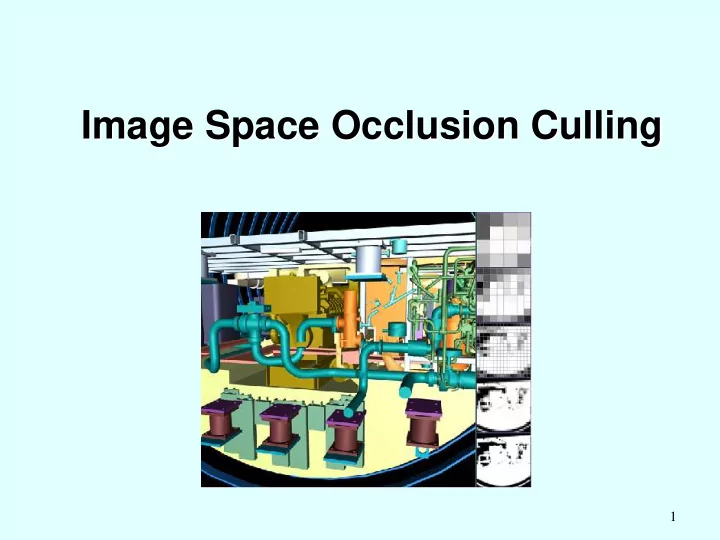

Image Space Occlusion Culling Image Space Occlusion Culling 1
Hudson et al, SoCG 97 Occluder A Viewpoint umbra B C 2
What Methods are Called Image-Space? • Those where the decision to cull or render is done after projection (in image space) Two classic examples – Hierarchical Z-Buffer [HBZ93] – Hierarchical Occlusion Maps [HOM97] Decision to cull Object space hierarchy View volume 3
Ingredients of an Image Space Method • An object space data structure that allows fast queries to the complex geometry Hierarchical bounding boxes Regular grid Space partitioning 4
An image space representation of the occlusion information • Discrete – Z-hierarchy – Occlusion map hierarchy • Continuous – BSP tree – Image space extends 5
General Outline of Image Space Methods • During the (front-to-back) traversal of the scene hierarchy do: – compare each node against the view volume – if not culled, test node for occlusion – if still not culled, render objects/occluders augmenting the image space occlusion 6
Testing a Node for Occlusion • If the box representing a node is not visible then nothing in it is either • The faces of the box are projected onto the image plane and tested for occlusion 7
Testing a Node for Occlusion • If the box representing a node is not visible then nothing in it is either • The faces of the box are projected onto the image plane and tested for occlusion 8
Hierarchical Tests O 9
Hierarchical Tests O 10
Hierarchical Tests O 11
Differences of Algorithms • The most important differences between the various approaches are: – the representation of the (augmented) occlusion in image space and, – the method of testing the hierarchy for occlusion 12
Hierarchical Z-Buffer (HZB) (Ned Greene, Michael Kass 93) • An extension of the Z-buffer VSD algorithm • It follows the outline described above. • Scene is arranged into an octree which is traversed top-to-bottom and front-to-back. • During rendering an occlusion map is incrementally built. • Octree nodes are compared against occlusion map. • The occlusion map is a z-pyramid… 13
The Z-Pyramid = furthest Objects are = closer rendered = closest Depth taken from the z-buffer Construct pyramid by taking max of each 4 17
Maintaining the Z-Pyramid • Ideally every time an object is rendered causing a change in the Z-buffer, this change is propagated through the pyramid • However this is not a practical approach 20
More Realistic Implementation • Make use of frame-to-frame coherence: – at start of each frame render the nodes that were visible in previous frame – read the z-buffer and construct the z-pyramid – now traverse the octree using the z-pyramid for occlusion but without updating it Cool idea! 21
HZB: discussion • It provides good acceleration in very dense scenes • Getting the necessary information from the Z-buffer is costly • A hardware modification was proposed for making it real-time 22
Hierarchical Occlusion Maps (Hansong Zhang et.al 97) Similar idea to HZB but: – they separate the coverage information from the depth information, two data structures • hierarchical occlusion maps • depth (several proposals for this) 23
HOM:Algorithm Outline – Select occluders until the set is large enough – Build occlusion representation – Occlusion culling & final rendering 24
Demonstration Blue parts: occluders occluders Blue parts: Red parts: occludees occludees Red parts: 25
Occlusion Map Pyramid 64 x 64 32 x 32 16 x 16 27
Occlusion Map Pyramid 29
Representing Occluders Set of Occluders Occlusion Map 32
Aggressive Approximate culling 0 1 2 3 4 35
Recommend
More recommend